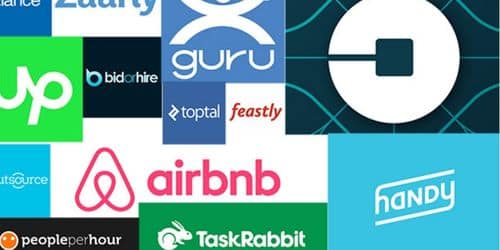The COVID-19 outbreak, which raised the number of people looking for methods to make up for lost income, has boosted the amount of attention paid to the gig economy during the past 12 months. Nowadays, many people view the gig economy as a “side hustle” that they plan to keep up in the future. Some people have even had the chance to alter their line of work, which they never even knew they desired! Despite this, from at least the start of the previous decade, the gig economy has been booming. In this essay, we’ll discuss the different gig economy companies, the issues with the gig economy as well as its benefits and disadvantages.
Read BEST APPS TO MAKE MONEY IN 2023
Gig Economy
The gig economy is a flexible economy that involves the exchange of labor and goods through online marketplaces that actively link buyers and sellers.
Businesses hire independent contractors and freelancers rather than full-time workers in the gig economy. As there is no regular schedule for the work, they deploy contractors and freelancers as needed.. Businesses like Uber, DoorDash, and Airbnb make similar arrangements.
The result of the gig economy is more adaptable, more inexpensive, and more efficient services that can provide customers with a unique and quick alternative to conventional, structured businesses. It runs online, making it a very popular option with young people.
A third of the population in the US work a gig-eligible job, according to estimates. therefore more businesses will use independent contractors as a means of time and cost savings.
Over the past five years, the gig economy has gained enormous popularity and is now a relatively common means for people to supplement their income.
More particularly, 1.6 million workers are thought to rely on the gig economy for their overseas income.
Gig Economy Companies
Some of the most well-known companies are represented in our ranking of the 6 well-known gig economy companies in the world, including Shopify Inc. (NYSE:SHOP), Uber Technologies, Inc. (NYSE:UBER), and Airbnb, Inc. (NASDAQ:ABNB).
individuals use this platform to promote their products or services online or through other digital channels. Also, as IT entrepreneurs are the primary contributors to the gig economy, we selected companies whose primary products are used by them. We have ranked these companies according to their market capitalization.
#1 Talkspace, Inc. (Nasdaq: Talk)
Has a Market Capitalization of $0.106 Billion as of November 3, 2022. Its headquarters are in New York. Talkspace, Inc. operates a secure web-based and mobile platform-based virtual behavioral healthcare service. Via text, audio, or video chat, users can communicate with their therapists in real-time. To suit every need, the company offers psychiatry, adolescent, individual, or couples therapy, among other forms of care. Users of Talkspace receive access to licensed therapists via the website or a mobile iOS or Android app. One of the pioneers in the area of internet treatment, Talkspace, has had poor profitability after becoming public in 2021. Recently, Talkspace, Inc. (NASDAQ: TALK) was approached by American Well but declined (AMWL). Before any numbers were discussed, Talkspace rejected American Well’s indication of interest.
#2 Bird Global, Inc. (NYSE: Brds)
Has a Market Capitalization of $0.123 Billion as of November 3, 2022. Bird Global, Inc.’s corporate office is located in Miami, Florida. A micro-mobility company called Bird Global, Inc. (NYSE: BRDS) provides electric short-distance transportation solutions. Among the shared vehicles it offers are e-scooters and e-bikes. The business offers a fleet of shared micro-electric cars to users of Bird. in addition to selling vehicles to distributors, merchants, and direct customers. Bird Global, Inc.’s (NYSE: BRDS) patented technology and business techniques are upending the status quo in the transportation sector by making lightweight electric vehicles freely accessible for rental or purchase. At the touch of a button, riders may effortlessly and swiftly transport themselves to their place of employment, a local business, or any other spot in their community.
#3 Rover Group, Inc. (NASDAQ: ROVR)
Has a market capitalization of $0.802 billion as of November 3, 2022. Rover Group, Inc. is in charge of the international online pet care business (NASDAQ: ROVR). The greatest internet market for pet care exists here. Rover Group, Inc. (NASDAQ: ROVR), like other gig economy businesses, acts as a middleman to link customers and service providers. It connects pet owners with service providers who offer daytime services like dog boarding and in-home pet sitting as well as nightly services like dog walking, dog daycare, drop-in visits, grooming, and training. Seattle, Washington, is home to the company headquarters.
Robert Mollins, an analyst at Gordon Haskett, lowered Rover Group, Inc.’s (NASDAQ: ROVR) rating from Buy to Hold on August 9 and lowered his price target from $5.50 to $3.50. One of the biggest gig economy businesses in the world, along with Shopify Inc. (NYSE: SHOP), Uber Technologies, Inc. (NYSE: UBER), and Airbnb, Inc. (NASDAQ: ABNB), is Rover Group, Inc. (NASDAQ: ROVR).
Bird Global, Inc. (NYSE: Brds)
Has a Market Capitalization of $0.123 Billion as of November 3, 2022. Denver, Colorado, serves as the home location for Angi Inc. (NASDAQ:ANGI), a 2017 incorporation. The largest US internet marketplace for home services run by Angi Inc. (NASDAQ:ANGI). Similar to Rover Group, Inc. (NASDAQ:ROVR) and other gig economy companies, Angi Inc. (NASDAQ:ANGI) conducts business. It links consumers in the United States and abroad with home service providers. Through the Angi nationwide online directory of service professionals in various service categories, its Angi Ads business connects customers with service professionals for local services. The business also owns and runs the online service marketplace Angi Leads, which links customers with contractors for home maintenance, repair, and improvement projects. It had a network of over 206,000 transaction service professionals as of December 31, 2021, and about 38,000 advertising service professionals.
#4 Fiverr International Ltd. (NYSE:Fvrr)
Has a Market Capitalization of $1.15 Billion as of November 3, 2022, Israeli company Fiverr International Ltd. (NYSE:FVRR) was established in 2010 and has its headquarters in Tel Aviv-Yafo. An international online market run by Fiverr International Ltd. (NYSE:FVRR). With nine verticals, including graphic and design, digital marketing, writing and translation, video and animation, music and audio, programming and technology, business, data, and lifestyle, the company’s platform has about 550 categories in total. Also, it offers Fiverr Workspace, a software program that enables independent contractors to handle invoices, contracts, time tracking, and workflow.
freelancer gets a commission for each sale they make through Fiverr’s marketplace. Additionally, it offers a variety of membership options to both buyers and sellers on the marketplace. There is little doubt that the expanding gig economy and the freelancing trend will lead to growth in Fiverr International Ltd.’s (NYSE:FVRR) user base in 2022 and beyond. After Fiverr International Ltd. (NYSE:FVRR) reported better-than-expected Q2 profits on August 5, Needham analyst Bernie McTernan increased his price objective for the stock to $50 from $40 while maintaining a Buy recommendation.
#5 Upwork Inc. (Nasdaq:Upwk)
Has a Market Capitalization of $1.77 Billion as of November 3, 2022. The headquarters of Upwork Inc. (NASDAQ:UPWK), a 2013 incorporation, is in San Francisco, California. Along with its subsidiaries, Upwork Inc. (NASDAQ:UPWK) runs a marketplace for work that links companies with different independent contractors and agencies in the United States, India, the Philippines, and globally. The job market operated by Upwork Inc. (NASDAQ:UPWK) offers access to people with a range of expertise in fields like customer service, online, mobile, and software development, as well as sales and marketing, data science and analytics, design, and creative.
Upwork Inc. (NASDAQ:UPWK) is expanding quickly as it investigates new jobs and areas. As a result, more people are visiting the website and, on average, they are spending more money. On October 27, Brad Erickson of RBC Capital cut his price objective for Upwork Inc. (NASDAQ:UPWK) from $21 to $15 while maintaining a Sector Perform rating for the stock. The company’s Q3 results were “mixed,” according to the analyst’s research note to investors, because macro headwinds and execution problems are still a concern.
#6 Lyft, Inc. (Nasdaq:Lyft)
Has a Market Capitalization of $5.16 Billion as of November 3, 2022. Lyft, Inc. (NASDAQ:LYFT) is headquartered in San Francisco. Lyft, Inc. (NASDAQ:LYFT) is a US and Canadian ridesharing marketplace. Lyft, Inc.’s (NASDAQ:LYFT) multimodal transportation networks offer customizable, on-demand mobility solutions. It offers a Ridesharing Marketplace, Express Drive, Lyft Rentals, and a network of shared bikes and scooters in several cities to meet users’ short-trip needs. Uber competes with Lyft (NASDAQ:LYFT). Lyft, Inc. (NASDAQ:LYFT), which competes with Uber, is rising in major US cities and sometimes charges less than taxis. By 2021, Lyft, Inc.a growing (NASDAQ:LYFT), has surpassed Uber as predicted. which is dropping, and holds 31% of the US market.
On November 4, Credit Suisse analyst Stephen Ju lowered his price target for Lyft, Inc. (NASDAQ:LYFT) from $46 to $35 before the release of the Q3 earnings report on November 7. However, he kept the stock’s Outperform rating. Ju cautions investors in a research note that the West Coast has lagged behind much of the country in the U.S. ridesharing revival, which has been inconsistent. According to the company’s Rides assessment, a delayed return to the 2019 cadence is now anticipated.
Issues with the Gig Economy
Issues with Employment in the Gig Economy
Although the gig economy has many advantages, it also has many issues that could make the process difficult.
The following is a list of issues gig economy companies face:
#1. Work Obligations
Freelancers might not be as committed to their business as full-time workers. Also, it’s uncommon for gig economy companies to provide incentives to their employees.
A situation of this nature from gig economy can create loyalty issues and lessen the chance that someone will find employment again, and lessen the incentive for work.
#2. Moral Concerns
The moral standards of businesses in the gig economy have been the subject of numerous issues. Their work is intermittent, unpaid, and typically low-paying.
#3 Job-Hopping
This has been one of the numerous issues facing the gig economy as workers know their time with your company is limited, they may start looking before your job is over. Once a freelancer left for other chances, several companies claimed they needed to replace them.
Staffing firms can handle another area. Workers are less inclined to quit early if they know the agency can help them locate a new job. Employers can quickly find replacements in the agency’s application pool.
Gig Economy Benefits
There are several benefits to working in the gig economy, and both employees and businesses can take advantage of them.
Here are a few benefits that gig economy businesses have noticed:
#1. Cost-Effectiveness
One of the main benefits of working in the gig economy is having the flexibility to lower costs and expenses, which is commonly mentioned. The ability to hire more employees without having to maintain expensive workspaces and large offices allows businesses to grow.
Furthermore, hiring independent contractors entirely eliminates the need for expensive outlays like paid sick leave, retirement plans, and employee perks.
#2. The Employees
A workforce made available by the gig economy might serve as a direct conduit between businesses and independent freelancers. As a result, dealing with a middleman throughout the hiring process is avoided, which makes hiring employees less challenging.
#3. Advancement of Products
Flexibility is becoming more valued among modern workers than it once was. As a result, the gig economy is thriving.
While looking to augment their income, people are driven to apply for employment with variable work schedules. The motivation of employees, which is favorably connected with output production, is immediately impacted by this type of adaptation.
The following are some of the benefits that the gig economy employees utilized:
#1. Independent Thinking
Independent contractors do not need offices to work in the gig economy; they can do it anywhere so Anything is feasible, from someone working from home to someone operating an Uber while doing so.
#2. Versatility
Employees in the gig economy can pick the hours they want to work. Normally, a task and a deadline are assigned to a worker, but the worker ultimately selects when they start working on it.
#3. Income
one of the common benefits of working in the gig economy is how flexible it is for people to earn extra money, as was already noted.gig economy is gaining popularity due to that
Disadvantages of Gig Economy
The following list of drawbacks to working in the gig economy includes:
#1. No benefits
Businesses in the gig economy do not give benefits to their workers. Not all non-company employees are considered “workers.”
#2. Personal Costs
Some gig economy companies don’t require their workers to pay for amenities like the gasoline they used while driving for DoorDash.
#3. Exclusion
A large lot of independence is necessary to work as an independent contractor. For some people, the arrangement can be a strong motivator, but it can also make them feel lonely, which can be detrimental to their productivity and mental health.
Is Uber a Gig Economy?
There are numerous businesses that fit under the gig economy category, including certain couriers, Deliveroo, Uber, and AirBnB, and there are more and more articles questioning the legal rights of workers who are “employed” by these businesses.
How Do Gig Economy Workers Get Paid?
There are several companies that fall under the gig economy umbrella, including some courier services, Deliveroo, Uber, and AirBnB, and an increasing number of articles are raising concerns about the legal rights of those who are “employed” by these companies.
Who Created the Gig Economy?
Former New Yorker editor Tina Brown first used the term “gig economy” in 2009. While they conducted business in a digital marketplace, workers in the knowledge sector were increasingly pursuing “a variety of free-floating projects, consultancies, and part-time bits and pieces,” according to the article.
What Are Some Examples of Gig Economy?
Taxi Driving and Ridesharing.
- Taxi Driving and Ridesharing
- Training and Education.
- Delivery services.
- Office administration.
- Software development
- Finance and accounting.
- Online advertising.
- Management of projects.
What Is the Problem of Gig Economy?
Companies in the gig economy are typically not recognized for rewarding their workers. An arrangement like this may lead to loyalty concerns, diminish the possibility of future work, and lower overall motivation for work.
How Do You Succeed in Gig Economy?
- Remain humane
- Use your skills with adaptability and flexibility.
- Ensure that your brand is still strong.
- With your gig, exercise patience.
Can You Make a Living in the Gig Economy?
The gig economy can be successful in a select few industries and skill sets Moreover, If you do not live in a very costly area, it may allow you to pursue new lifestyle options even though it may not pay as well as comparable work in a respectable company.
whereas on the other hand
Most people who attempt to support themselves only through the gig economy fail miserably and lastly, It lacks all the advantages that steady jobs have historically provided to employees and was never intended to take the place of full-time employment.
What Is the Most Profitable Gig Economy Job?
Selling real estate, including residential and commercial properties, is the gig that pays the most money in addition The maximum hourly pay for this profession is $81, while the average monthly salary is $500.






